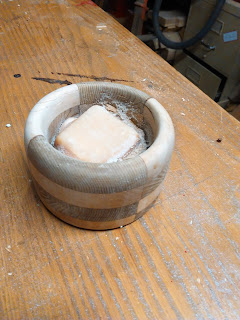The underside of my latest raised work bench shows two pipe clamps.
The pipe clamps enable me to face clamp long boards to the bench for planing. The only problem was the end of the clamp would twist and so not engage the bench, so I sometimes needed three hands, one for each end of the clamp and one for the board.
Problem solved.
I cut two 3 1/2 inch oak rounds from 3/4 wood, drilled a 7/8 inch whole in the center and now the end of the clamp holds the oak washer and the washer always engages the edge of the bench. I did not have a 7/8th forstner bit so I drilled the holes with an auger bit and hand brace. To keep the oak from splitting as the tip of the auger bit forces its way in, before the cutting parts of the bit engage I drilled a pilot hole through the board.
Another jig, this is a planing stop that is held in place by the pipe clamp, newly efficient with the oak washers. All the jigs in my shop are red, orange or purple, I need to be able to see them easily.
Last week I made the frame for the light fixture. Yesterday the electrician came and put the light up in our front hallway.
Fifteen bulbs hang down from eight to twelve feet from the ceiling. My wife is planning small stained glass shades for every light bulb. It is going to be very cool when it is done. We've waited for a long time to light that space properly.
Yesterday's project was a small thing, made from re-cycled wood. A while ago I took and the old dresser in the corner apart and salvaged as much of the wood from the drawers as possible.
I got enough for several small projects,
and the recent small project was cut out and clamped up yesterday.
If you don't make small craft type projects you probably don't realize how much pleasure resides in a small 'nothing' like this. It was a damp over cast day so spending the afternoon in the shop designing, cutting and sanding while listening to pod casts was quite enjoyable.
My Mom was given this Christmas ornament this year and it sat on her dinner table. It didn't have stand so it was sort of balanced on another jar and the power cord was visible and it was a good idea that wasn't quite finished.
To make that little stand I used the last piece of dresser drawer, which is solid wood because that was the way things were done in the 'ol days". I cut the half circle on my scroll saw, only to discover I had only one blade left. Everything was squared, glued and clamped and left to dry while I did some shop maintenance. Once the glue dried I sanded it to 400 grit by hand then shellacked in and gave it a hand buffed coat of bee's wax. It is smooth to the touch with a gentle warm glow. Since the wood was cut over 75 years ago I thought a traditional finish was appropriate.
Little jobs like this are great as a quiet diversion on a stay at home day. Next I have a couple of decorative boxes to make and a fairly big restoration project awaiting my immediate attention.
As long as the weather stays seasonal I am all set.































